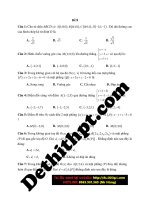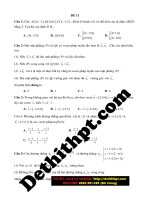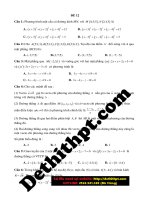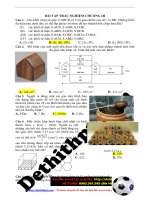Đề 33 image marked image marked
Bạn đang xem bản rút gọn của tài liệu. Xem và tải ngay bản đầy đủ của tài liệu tại đây (1.75 MB, 8 trang )
Exercise 33:
Read the following passage and mark the letter A, B, C or D to indicate the correct answer to each
of the questions.
Although only a small percentage of the electromagnetic radiation that is emitted by the Sun is
ultraviolet (UV) radiation, the amount that is emitted would be enough to cause severe damage to most
forms of life on Earth were it all to reach the surface of the Earth. Fortunately, all of the Sun’s ultraviolet
radiation does not reach the Earth because of a layer of oxygen, called the ozone layer encircling the
Earth in the stratosphere at an altitude of about 15 miles above the Earth. The ozone layer absorbs much
of the Sun’s ultraviolet radiation and prevents it from reaching the Earth.
Đăng ký file Word tại link sau
/>
Ozone is a form of oxygen in which each molecule consists of three atoms (O3) instead of the two
atoms (O2) usually found in an oxygen molecule. Ozone forms in the stratosphere in a process that is
initiated by ultraviolet radiation from the Sun. UV radiation from the Sun splits oxygen molecules with
two atoms into free oxygen atoms, and each of these unattached oxygen atoms then joins up with an
oxygen molecule to form ozone. UV radiation is also capable of splitting up ozone molecules; thus, ozone
is constantly forming, splitting, and reforming in the stratosphere. When UV radiation is absorbed during
the process of ozone formation and reformation, it is unable to reach Earth and cause damage there.
Recently, however, the ozone layer over parts of the Earth has been diminishing. Chief among the
culprits in the case of the disappearing ozone, those that are really responsible, are the
chlorofluorocarbons (CFCs). CFCs meander up from Earth into the stratosphere, where they break down
and release chlorine. The released chlorine reacts with ozone in the stratosphere to form chlorine
monoxide (ClO) and oxygen (O2). The chlorine then becomes free to go through the cycle over and over
Trang 1
again. One chlorine atom can, in fact, destroy hundreds of thousands of ozone molecules in this
repetitious cycle, and the effects of this destructive process are now becoming evident.
QUESTION
Question 1: According to the passage, ultraviolet radiation from the Sun ______,
A. is causing severe damage to the Earth's ozone layer
B. is only a fraction of the Sun's electromagnetic radiation
C. creates electromagnetic radiation
D. always readies to attack the Earth
Question 2: The word "encircling" in paragraph 1 is closest in meaning to______.
A. rotating
B. attacking
C. raising
D. surrounding
Question 3: It is stated in the passage that the ozone layer _________.
A. enables ultraviolet radiation to reach the Earth
B. reflects ultraviolet radiation
C. shields the Earth from a lot of ultraviolet radiation
D. reaches down to the Earth
Question 4: According to the passage, an ozone molecule____________.
A. consists of three oxygen molecules
B. contains more oxygen atoms than the usual oxygen molecule does
C. consists of two oxygen atoms
D. contains the same number of atoms as the usual oxygen molecule
Question 5: The word "free" in paragraph 2 could best be replaced by _____.
A. liberal
B. gratuitous
C. unconnected
D. emancipated
Question 6: Ultraviolet radiation causes oxygen molecules to _______.
A. rise to die stratosphere
B. burn up ozone molecules
c. split up and reform as ozone
D. reduce the number of chlorofluorocarbons
Question 7: The pronoun "it" in paragraph 2 refers to__________.
Trang 2
A. radiation
B. process
C. formation
D. damage
Question 8: The word "culprits" in paragraph 3 is closest in meaning to which of the following?
A. Guilty parties
B. Detectives
C. Group members
D. Leaders
Question 9: According to the passage, what happens after a chlorine molecule reacts with an ozone
molecule?
A. The ozone breaks down into three oxygen atoms.
B. Two different molecules are created.
C. The two molecules combine into one molecule.
D. Three distinct molecules result.
Question 10: The paragraph following the passage most likely discusses
A. the negative results of the cycle of ozone destruction
B. where chlorofluorocarbons (CFCs) come from
C. the causes of the destruction of ozone molecules
D. how electromagnetic radiation is created
GIẢI CHI TIẾT
Question 1: According to the passage, ultraviolet radiation from the Sun
.
A. is causing severe damage to the Earth's ozone layer
B. is only a fraction of the Sun's electromagnetic radiation
C. creates electromagnetic radiation
D. always readies to attack the Earth
Dịch nghĩa: Theo như trong đoạn văn, tia cực tím từ mặt trời _______.
A. đang gây ra tổn hại nghiêm trọng tới tầng ozon của trái đất
B. chỉ là một lượng nhỏ của bức xạ điện từ của mặt trời
C. gây ra bức xạ điện từ
D. luôn luôn sẵn sàng tấn công Trái đất
Giải thích: đọc ngay câu đầu tiên của đoạn văn: "Although only a small percentage of the
electromagnetic radiation that is emitted by the Sun is ultraviolet (UV) radiation" (mặc dù chỉ một lượng
nhỏ bức xạ điện từ cái mà được phóng ra từ mặt trời là tia cực tím)
Ta có cụm: a fraction of - a small percentage of: một lượng nhỏ cái gì
Trang 3
Question 2: The word "encircling" in paragraph 1 is closest in meanging to ___.
A. rotating
B. attacking
C. raising
D. surrounding
Dịch nghĩa: Từ "encircling" ở đoạn 1 có nghĩa gần nhất với __________.
A quay vòng quanh
B. tấn công
C. tăng lên, dâng lên
D. bao quanh
Giải thích: encircle = surround: bao quanh
Question 3: It is stated in the passage that the ozone layer ______________.
A. enables ultraviolet radiation to reach the Earth
B. reflects ultraviolet radiation
C. shields the Earth from a lot of ultraviolet radiation
D. reaches down to the Earth
Dịch nghĩa: Ta có thể suy ra từ đoạn văn rằng tầng ozon ______________.
A. có thể cho tia cực tím chạm vào trái đất
B. phản chiếu tia cực tím
C. bảo vệ trái đất khỏi rất nhiều tia cực tím
D. chạm vào trái đất
Giải thích: đọc câu "The ozone layer absorbs much of the Sun's ultraviolet radiation and prevent it from
reaching the Earth" (Tầng ozon hút những tia cực tím của mặt trời và ngăn không cho chúng chạm tới trái
đất.
Question 4: According to the passage, an ozone molecule ______________.
A. consists of three oxygen molecules
B. contains more oxygen atoms than the usual oxygen molecule does
C. consists of two oxygen atoms
D. contains the same number of atoms as the usual oxygen molecule
Dịch nghĩa: Theo như đoạn văn, một phân tử ozon ______.
A. chứa 3 phân tử oxi
B. chứa nhiều nguyên tử oxi hơn một phân tử khí oxi thông thường
Trang 4
C. chứa hai nguyên tử oxi
D. chứa số nguyên tử oxi bằng số phân tử khí oxi thông thường
Giải thích: câu đầu tiên của đoạn 2 "Ozone is a form of oxygen in which each molecule consists of three
atoms (03) instead of the two atoms (02) usually found in an oxygen molecule" (Ozon là một dạng của
oxi nhưng mỗi phân tử ozon (03) chứa 3 nguyên tử oxi thay vì 2 nguyên tử oxi trong 1 phân tử khí oxi
(02) thông thường)
Question 5: The word "free" in paragraph 2 could best be replaced by ___.
A. liberal
B. gratuitous
C. unconnected
D. emancipated
Dịch nghĩa: Từ "free" ở dòng 14 có thể được thay thế hợp lí nhất bởi_____.
A. suy nghĩ thoáng, cởi mở, không bị gò bó bởi những quan niệm truyền thống
B. cho không
C. không liên kết với nha
D. được giải phóng khỏi sự căng thẳng chính trị, tôn giáo
Giải thích: "uv radiation from the sun splits oxygen molecules with two atoms into free oxygen atoms"
(Tia cực tím từ mặt trời tách các phân tử khí oxi thành hai nguyên tử oxi tự do)
Question 6: Ultraviolet radiation causes oxygen molecules to ___________.
A. rise to destroy stratosphere
B. burn up ozone molecules
C. split up and reform as ozone
D. reduce the number of chloroflourocarbons
Dịch nghĩa: Tia cực tím làm cho phân tử oxi(O2) ________.
A. tăng lên để hủy tầng bình lưu
B. đốt cháy phân tử ozon
C. tách ra và tái hợp lại thành ozon
D. giảm số lượng khí CFCs
Giải thích: "UV radiation from the sun splits oxygen molecules with two atoms into free oxygen atoms,
and each of these unattached oxygen atoms then joins up with an oxygen molecules to form ozone" (Tia
cực tím từ mặt trời tách các phân tử khí oxi thành hai nguyên tử oxi tự do, mỗi nguyên tử oxi tách biệt ấy
sẽ lại kết hợp với các phân tử khí oxi tạo thành ozon)
Question 7: The pronoun "it" in paragraph 2 refers to _________.
A. radiation
B. process
C. formation
D. damage
Dịch nghĩa: Đại từ "it" ở đoạn 2 chỉ __________.
A. tia phóng xạ
B. quá trình
C. sự tạo thành
D. thiệt hại
Trang 5
Giải thích: "When uv radiation is absorbed during the process of ozone formation and reformation, it is
unable to reach Earth and cause damage there" (Khi các tia cực tím bị hút trong suốt quá trình tạo thành
và tái tạo ozon, nó không thể chạm đến và gây tổn hại đến trái đất)
Question 8: The word "culprits" in paragraph 3 is closest in meaning to which of the following?
A. guilty parties
B. detective
C. group members
D. leaders
Dịch nghĩa: Từ "culprits" ở đoạn 3 có nghĩa gần nhất với từ nào trong những từ sau?
A. những nhân tố gây thiệt hại
B. thám tử
C. thành viên trong nhóm
D. những người lãnh đạo
Giải thích: "Recently, however, the ozone layer over parts of the Earth has been disminishing, chief
among the culprits in the case of the disappearing ozone, those that are really responsible, are the
chlorofluorocarbons (CFCs)" (Tuy nhiên gần đây tầng ozon bên ngoài trái đất ngày càng giảm đi, nguyên
nhân chính trong những nguyên nhân gây ra sự biến mất của ozon là khí chlorofluorocarbons (CFCs)
Question 9: According to the passage, what happens after a chlorine molecule reacts with an ozone
molecule?
A. The ozone breaks down into three oxygen atoms
B. Two different molecules are created
C. The two molecules combine into one molecule
D. Three distinct molecules result
Dịch nghĩa: Theo đoạn văn, điều gì xảy ra sau khi phân tử clo phản ứng với một phân tử ozon?
A. Phân tử ozone bị phân chia thành 3 nguyên tử oxi
B. Hai phân tử khác nhau được tạo thành
C. Hai phân tử kết hợp thành một phân tử
D. Kết quả là 3 phân tử khác nhau
Giải thích: "The released chlorine reacts with ozone in the stratosphere to form chlorine monoxide (ClO)
and oxygen (02)" (Các phân tử clo phản ứng với ozon trong tầng bình lưu tạo thành một phân tử khí ClO
và một phân tử 02).
Question 10: The paragraph following the passage most likely discusses .
A. the negative results of the cycle of ozone destruction
B. where chlorofluorocarbons (CFCs) come from
Trang 6
C. the cause of the destruction of ozone molecules
D. how electromagnetic radiation is created
Dịch nghĩa: Đoạn văn tiếp theo sẽ có thể bàn luận về _________.
A. hậu quả xấu của quá trình phá hủy tầng ozon
B. nơi mà khí CFCs sinh ra
C. nguyên nhân của sự phá hủy phân tử ozon
D. tia bức xạ điện từ được sinh ra như thế nào
Giải thích: Câu cuối của đoạn văn "One chlorine atom can, in fact, destroy hundreds of thousands of
ozone molecules in this repetitious cycle, and the effects of this destructive process are now becoming
evident" (Thực tế một nguyên tử Clo có thể phá hủy hàng trăm nghìn phân tử ozon bằng chu kì lặp lại đó
và ảnh hưởng của quá trình phá hủy này ngày nay càng trở nên rõ ràng)
DỊCH BÀI
Mặc dù chỉ một lượng rất nhỏ bức xạ điện từ được phóng ra từ mặt trời là tia cực tím, nó cũng sẽ đủ
để gây ra những thiệt hại nghiêm trọng tớ hầu hết các loài sinh vật trên trái đất nếu nó chạm đến bề mặt
trái đất. May mắn là những tia cực tím không thể chạm đến bề mặt trái đất bởi đã có một tầng oxi, còn gọi
là tầng ozon bao quanh trái đất trong tầng bình lưu ở độ cao 15 dặm bên trên trái đất. Tầng ozon hút
những tia cực tím của mặt trời và ngăn không cho chúng chạm tới trái đất.
Ozon là một dạng của oxi nhưng mỗi phân tử ozon (O3) chứa 3 nguyên tử oxi thay vì 2 như trong 1
phân tử khí oxi (O2) thông thường. Ozon tạo ra trong tầng bình lưu theo một quá trình được khởi đầu bởi
những tia cực tím từ mặt trời. Tia cực tím từ mặt trời tách các phân tử khí oxi thành hai nguyên tử oxi tự
do, mỗi nguyên tử oxi tách biệt ấy sẽ lại kết hợp với các phân tử khí oxi tạo thành ozon, tia cực tím cũng
có khả năng tách các phân tử ozon chính vì thế mà ozon liên tục được tạo thành, phân chia rồi lại tái tạo
trong tầng bình lưu. Khi các tia cực tím bị hút trong suốt quá trình tạo thành và tái tạo ozon, nó không thể
chạm đến và gây tổn hại đến trái đất.
Trang 7
Tuy nhiên gần đây tầng ozon bên ngoài trái đất ngày càng giảm đi, nguyên nhân chính gây ra sự biến
mất của ozon là khí chlorofluorocarbons (CFCs). CFCs bay quanh co từ trái đất lên tầng bình lưu nơi mà
chúng phân chia và thải ra các phân tử clo. Các phân tử clo phản ứng với ozon trong tầng bình lưu tạo
thành một phân tử khí ClO và một phân tử O2. Các phân tử clo sau đó trở nên tự do và lặp lại quá trình
này. Thực tế một nguyên tử clo có thể phá hủy hàng trăm nghìn phân tử ozon bằng chu kì lặp lại đó và
ảnh hưởng của quá trình phá hủy này ngày nay càng trở nên rõ ràng.
Trang 8









